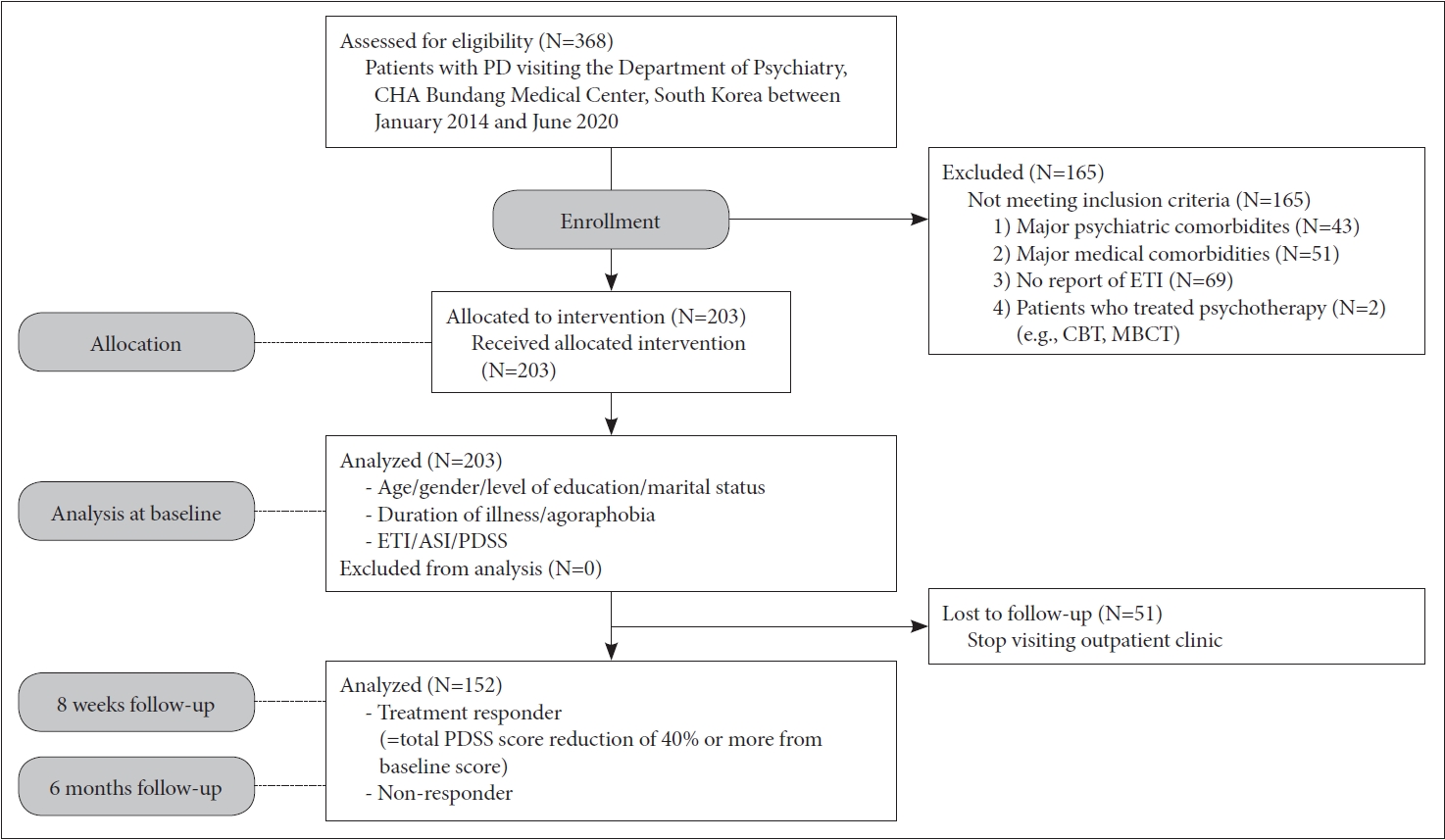1. American Psychiatric Association. Diagnostic and Statistical Manual of Mental Disorders (DSM-5®). Washington DC: American Psychiatric Pub; 2013.
3. Hong J, Lee D, Ham B, Lee S, Sung S, Yoon T. The Survey of Mental Disorders in Korea 2016. Seoul: Ministry of Health and Welfare; 2017.
7. Bandelow B, R├╝ther E. Treatment-resistant panic disorder. CNS Spectr 2004;9:725-739.


8. Bandelow B, Behnke K, Lenoir S, Hendriks G, Alkin T, Goebel C, et al. Sertraline versus paroxetine in the treatment of panic disorder: an acute, double-blind noninferiority comparison. J Clin Psychiatry 2004;65:405


9. Freire RC, Hallak JE, Crippa JA, Nardi AE. New treatment options for panic disorder: clinical trials from 2000 to 2010. Expert Opin Pharmacother 2011;12:1419-1428.


10. Albus M, Scheibe G, Scherer J. Panic disorder with or without concomitant depression 5 years after treatment: a prospective follow-up. J Affect Disord 1995;34:109-115.


12. Noyes Jr R, Garvey MJ, Cook BL. Follow-up study of patients with panic disorder and agoraphobia with panic attacks treated with tricyclic antidepressants. J Affect Disord 1989;16:249-257.


13. Noyes R, Reich J, Christiansen J, Suelzer M, Pfohl B, Coryell WA. Outcome of panic disorder: relationship to diagnostic subtypes and comorbidity. Arch Gen Psychiatry 1990;47:809-818.


14. Scheibe G, Albus M. Predictors and outcome in panic disorder: a 2-year prospective follow-up study. Psychopathology 1997;30:177-184.


15. Sharp D, Power K. Predicting treatment outcome for panic disorder and agoraphobia in primary care. Clin Psychol Psychother 1999;6:336-348.

16. Slaap BR, den Boer JA. The prediction of nonresponse to pharmacotherapy in panic disorder: a review. Depress Anxiety 2001;14:112-122.


18. Kipper L, Blaya C, Wachleski C, Dornelles M, Salum GA, Heldt E, et al. Trauma and defense style as response predictors of pharmacological treatment in panic patients. Eur Psychiatry 2007;22:87-91.


19. Horesh N, Amir M, Kedem P, Goldberger Y, Kotler M. Life events in childhood, adolescence and adulthood and the relationship to panic disorder. Acta Psychiatr Scand 1997;96:373-378.


20. Zou Z, Huang Y, Wang J, He Y, Min W, Chen X, et al. Association of childhood trauma and panic symptom severity in panic disorder: exploring the mediating role of alexithymia. J Affect Disord 2016;206:133-139.


21. Kim HJ, Song C, Bang M, Lee SH. Early sexual trauma is related with the tapetum in patients with panic disorder. J Affect Disord 2020;267:107-113.


22. Hayasaka Y, Purgato M, Magni LR, Ogawa Y, Takeshima N, Cipriani A, et al. Dose equivalents of antidepressants: evidence-based recommendations from randomized controlled trials. J Affect Disord 2015;180:179-184.


23. Gim M, Kim MK, Lee JH, Kim W, Moon E, Seo HJ, et al. Korean guidelines for the treatment of panic disorder 2018: Psychosocial treatment strategies. Anxiety Mood 2019;15:13-19.
24. Simon N, Hollander E, Rothbaum BO, Stein DJ. The American Psychiatric Association Publishing Textbook of Anxiety, Trauma, and OCD-Related Disorders. American Psychiatric Pub; 2020.
26. Lim YJ, Yu BH, Kim JH. Korean anxiety sensitivity indexŌĆörevised: its factor structure, reliability, and validity in clinical and nonclinical samples. Depress Anxiety 2007;24:331-341.


27. Taylor S, Cox BJ. An expanded anxiety sensitivity index: evidence for a hierarchic structure in a clinical sample. J Anxiety Disord 1998;12:463-483.

28. Shear MK, Brown TA, Barlow DH, Money R, Sholomskas DE, Woods SW, et al. Multicenter collaborative panic disorder severity scale. Am J Psychiatry 1997;154:1571-1575.


29. Beck AT, Steer RA, Brown GK. Beck Depression Inventory (BDI-II). San Antonio: TX: Psychological Corp; 1996.
30. Barlow DH, Gorman JM, Shear MK, Woods SW. Cognitive-behavioral therapy, imipramine, or their combination for panic disorder: a randomized controlled trial. JAMA 2000;283:2529-2536.


31. Aaronson CJ, Shear MK, Goetz RR, Allen LB, Barlow DH, White KS, et al. Predictors and tie course of response among panic disorder patients treated with cognitive-behavioral therapy. J Clin Psychiatry 2008;69:418-424.


33. Stewart SH, Taylor S, Jang KL, Cox BJ, Watt MC, Fedoroff IC, et al. Causal modeling of relations among learning history, anxiety sensitivity, and panic attacks. Behav Res Ther 2001;39:443-456.


34. McNally RJ. Anxiety sensitivity and panic disorder. Biol Psychiatry 2002;52:938-946.


35. Kim HS, Kim HY. Factors predicting medication compliance among elderly visitors of public health centers. J Korean Acad Community Health Nurs 2007;18:5-13.
37. Goodwin RD, Fergusson DM, Horwood LJ. Childhood abuse and familial violence and the risk of panic attacks and panic disorder in young adulthood. Psychol Med 2005;35:881-890.


38. Yu ST, Lee KS, Lee SH. Fornix microalterations associated with early trauma in panic disorder. J Affect Disord 2017;220:139-146.


41. Harvey BH, McEwen BS, Stein DJ. Neurobiology of antidepressant withdrawal: implications for the longitudinal outcome of depression. Biol Psychiatry 2003;54:1105-1117.












